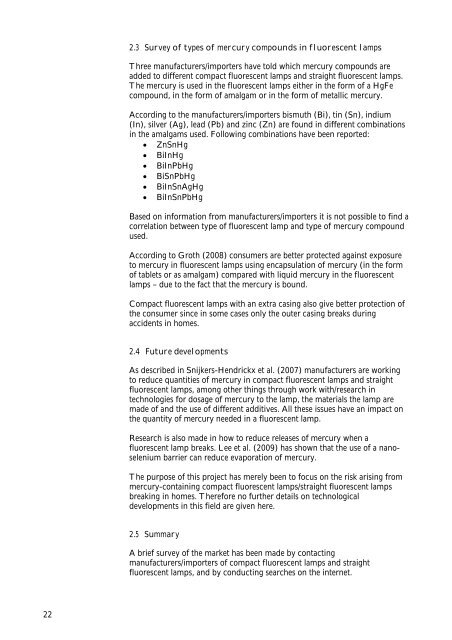No. 104 - Miljøstyrelsen
No. 104 - Miljøstyrelsen
No. 104 - Miljøstyrelsen
You also want an ePaper? Increase the reach of your titles
YUMPU automatically turns print PDFs into web optimized ePapers that Google loves.
22<br />
2.3 Survey of types of mercury compounds in fluorescent lamps<br />
Three manufacturers/importers have told which mercury compounds are<br />
added to different compact fluorescent lamps and straight fluorescent lamps.<br />
The mercury is used in the fluorescent lamps either in the form of a HgFe<br />
compound, in the form of amalgam or in the form of metallic mercury.<br />
According to the manufacturers/importers bismuth (Bi), tin (Sn), indium<br />
(In), silver (Ag), lead (Pb) and zinc (Zn) are found in different combinations<br />
in the amalgams used. Following combinations have been reported:<br />
� ZnSnHg<br />
� BiInHg<br />
� BiInPbHg<br />
� BiSnPbHg<br />
� BiInSnAgHg<br />
� BiInSnPbHg<br />
Based on information from manufacturers/importers it is not possible to find a<br />
correlation between type of fluorescent lamp and type of mercury compound<br />
used.<br />
According to Groth (2008) consumers are better protected against exposure<br />
to mercury in fluorescent lamps using encapsulation of mercury (in the form<br />
of tablets or as amalgam) compared with liquid mercury in the fluorescent<br />
lamps – due to the fact that the mercury is bound.<br />
Compact fluorescent lamps with an extra casing also give better protection of<br />
the consumer since in some cases only the outer casing breaks during<br />
accidents in homes.<br />
2.4 Future developments<br />
As described in Snijkers-Hendrickx et al. (2007) manufacturers are working<br />
to reduce quantities of mercury in compact fluorescent lamps and straight<br />
fluorescent lamps, among other things through work with/research in<br />
technologies for dosage of mercury to the lamp, the materials the lamp are<br />
made of and the use of different additives. All these issues have an impact on<br />
the quantity of mercury needed in a fluorescent lamp.<br />
Research is also made in how to reduce releases of mercury when a<br />
fluorescent lamp breaks. Lee et al. (2009) has shown that the use of a nanoselenium<br />
barrier can reduce evaporation of mercury.<br />
The purpose of this project has merely been to focus on the risk arising from<br />
mercury-containing compact fluorescent lamps/straight fluorescent lamps<br />
breaking in homes. Therefore no further details on technological<br />
developments in this field are given here.<br />
2.5 Summary<br />
A brief survey of the market has been made by contacting<br />
manufacturers/importers of compact fluorescent lamps and straight<br />
fluorescent lamps, and by conducting searches on the internet.

















